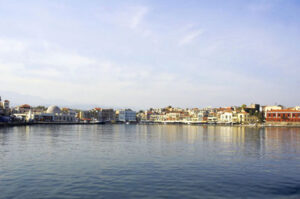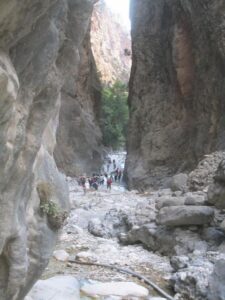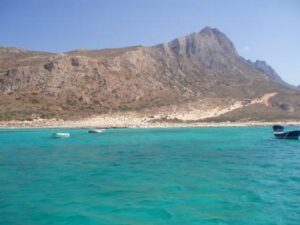Tour of Chania Prefecture
Chania prefecture covers the westernmost quarter of Crete with an area of 2.376 square kilometers.
Its capital is the city of Chania.
The prefecture also includes the southernmost island in Europe Gavdos.
It is divided into 5 provinces: Apokoronas, Kissamos, Kydonia, Selino and Sfakia.
LAKE KOURNA
South-west of Rethymnon lies LAKE KOURNA, the only one on Crete, with the Lefka Ori (White Mountains) rising in the background.
The lake has a perimeter of 3,5 km.
GEORGIOUPOLIS
A short distance away, is the sea-side settlement of GEORGIOUPOLIS, which has several tourist units and a fine organized beach with many beach bars and restaurants along it.
Kalivaki is a fine sandy beach west of the Georgioupolis river.
Futher west is VRYSES, a village with plentiful waters and much vegetation.
Three picturesque villages in the interior are Asi Gonia, built on a fairly inaccessible site, Askyfou, on the plateau of the same name and Imbros (or Nimbros), on a small plateau near the gorge of Imbros.
Tour of Chania Prefecture
Further south is CHORA SFAKION, a picturesque harbor built in an accessible, barren area on the rocky south coast of the prefecture of Chania.
Visitors can enjoy the clear sea, the quiet and calm of the village, on the seaside cafes and taverns.
You will find a few hotels and rooms to let.
The county of Sfakia is mountainous and one of the most heroic, beautiful, traditional and interesting of Crete.
Just to the east on this coast lies FRANGOKASTELO, one of the trademarks of Crete.
It is a small and quiet seaside village with a few houses, rooms and apartments for rent.
FRANGOKASTELO
Frangokastelo is famous for its impressive castle built by the Venetians in 1371.
The famous Battle of Frangokastelo took place in 1828 during the War of Independence.
The Cretan troops sought refuge in the castle and the Turks besiege it for 7 days.
During this siege the Greek leader and 350 of his men died.
Locals managed to help the troops and to force the Turks to retreat and let the men exit the castle.
The Turks demolished a part of the castle and left towards north-east where the locals were waiting for them.
All the Turks were slaughtered.
FRANGOKASTELO
Since this terrible event a strange phenomenon is taking place on the day of the anniversary of the Frangokastelo Battle on 17th May.
At the break of dawn, a long procession of visions of men dressed in black, with weapons walking and riding, is marching from the ruined church of Saint Charalambos to the castle.
When the procession reaches the sea it disappears at the first ray of the sun.
The phenomenon is called “Drosoulites” and lasts about 10 minutes.
In front of the castle, you will find a fine sandy beach with crystal clear waters, ideal for families with children.
On the New National Highway from Rethymno to Chania, we come to Ancient Aptera, with its imposing Cyclopean walls and the enormous cisterns.
SOUDA
To the north-east is SOUDA, the most important harbor in west Crete, built on the bay of the same name.
At the entrance to the bay is the small island of Souda, on which the Venetians built a strong fortress between 1570 and 1573.
Tour of Chania Prefecture
CHANIA
The highway ends at CHANIA, the capital of the prefecture of the same name, and the administrative, commercial, economic and public transport center of west Crete.
Chania is the main town in the west of Crete, with the second largest population after Heraklion.
It is considered one of the most beautiful towns of Greece and disposes an excellent tourist infrastructure.
The town has largely retained its old atmosphere.
It is divided into two parts – the New Town which is where the day to day business of the Chania goes on, with its shops, offices, banks, – and the Old Town, built around the Venetian harbor with numerous picturesque narrow streets and architecture showing the influence of decades of foreign domination.
Old Town of Chania
The Old Town of Chania has managed to preserve its cultural heritage and traditional architecture and to successfully combine it with its modern lifestyle.
A walk in the narrow streets of the old city offers nostalgic images from the past. It is one of the finest towns in Greece, with many traces of its past that lend it a distinctive charm.
Entire Venetian districts are preserved, as well as Turkish and Jewish quarters with well-preserved buildings, while the modern, continually expanding part of the town has a fine town-plan with a good street-grid, parks and modern buildings.
The Venetian port provides pleasant promenades through picturesque streets and attracts many visitors throughout the year.
There are also many bars and restaurants by the seaside for every taste.
At the entrance to the harbor is the Firkas fort, built in 1629, which now houses the Chania Nautical Museum and a summer theater.
Opposite is the 16th c. Venetian lighthouse.
CHANIA
The large Venetian church of Saint Francis is now the home of the Chania Archaeological Museum, which has important finds from all over west Crete.
Characteristic buildings in the town include: the imposing municipal indoor market, the renovated mosque of 1645 in the harbor, the Turkish baths, the Venetian mansion, the Renieri Gate and the Chania Cathedral (Three Martyrs).
The new Halepa quarter is also worth-seeing.
It houses the palace of the High Commissioner, the residence of Eleftherios Venizelos and the church of Saint Magdalene which was built according to the Russo-Byzantine architectural style.
Just to the south of the town is the monastery of Chryssopigi (or Zoodochos Pigi), which was founded about 1600 and is encircled by a fortification wall.
The nice beach of Germaniko Pouli is situated 2 kilometers to the west of the capital. It is a large sandy beach with many tourist facilities and accommodation options.
Tour of Chania Prefecture
Agia Marina is a long sandy beach and one of the most important tourist resorts of Chania.
There are several beach bars and water sports facilities.
Agii Apostoli is a nice sandy beach with shallow waters ideal for families with children.
The beach is fully organized, sun beds, umbrellas and water sport facilities are available.
Near the beach there are numerous hotels, apartments and rooms to let, restaurants, taverns with traditional Cretan delicaties, coffee shops and beach bars.
Continuing to the west, we come to the verdant village of MOURNIES, the birthplace of Eleftherios Venizelos, where his house containing some of his personal objects can be seen.
Further south is the historic village of THERISSO and the Gorge of Therisso (or Venizelos Gorge). It was from Therisso that Venizelos proclaimed his revolt against the regime of Prince George in 1905 (the Therisso Revolt).
AKROTIRI
The peninsula of AKROTIRI, north-east of the town has several interesting sights: the austere tomb of Eleftherios and Sofokles Venizelos stands on the hill of Profitis Elias. There is a breath-taking view from the hill over the town and the endless beach.
To the east of the town, near the village of Sternes, is the Chania Airport, with the monastery of Agia Triada Zangarola, which has some rare books, to the north.
The monastery of Gouverneto, 4 kilometers away, is set in a fortified quadrangle, and further north still is the monastery of Saint John Erimitis, or Xenos, better known as Katholiko.
It is set in a gorge and has a small church carved out of the rock.
Koumares, Korakies and Aroni are fine traditional villages on the Akrotiri peninsula, and one of the most popular beaches in the area is KALATHAS, which has several tourist facilities.
SAMARIA GORGE
South of Chania, in the heart of the prefecture, is the OMALOS PLATEAU, surrounded by high peaks, with the small village of OMALOS (39 kilometers from Chania).
The road crosses the plateau and after 4 kilometers comes to the Xyloskalo Pass, at a height of 1.227 meters, and the entrance to the GORGE OF SAMARIA.
It is 16 km in length and its width ranges from 3.5 to 150 meters, with vertical cliffs which may reach a sheer 500 meters in height.
There is a small Tourist Pavilion here with an enchanting view over the area.
Just before Xyloskalo, a small road leads to the Kallergis Ski Center, at 1.680 meters.
Those who have planned to walk through the Samaria Gorge begin the descent from Xyloskalo, initially following steps, and later a path.
A gentle stream flows along the way, becoming a rushing river in winter.
SAMARIA GORGE
The village of Samaria lies just inside the gorge.
It was finally abandoned by the last remaining inhabitants in 1962 to make way for the park.
The village and the gorge take their names from the village’s ancient church, Ossia María (Siamaria = Samaria). The old houses still exist and they serve as houses for the guards.
The narrowest point of the Samaria’s Gorge is known as “Portes” (Gates). It is the most photographed part of the gorge because steep cliffs rise dramatically to a height of over 300m with a very narrow passage of only 3.5m.
The Gorge of Samaria has been proclaimed a National Park in 1962, to protect its rare flora and faun, especially the wild ibex that lives here, known locally as “kri-kri”. It has recently received a Council of Europe prize as one of the most virgin and beautiful natural regions on the European continent.
This is one of the longest and most imposing gorges in Europe.
The descent is quite difficult and takes about 6 – 8 hours.
Visitors may walk the gorge from the beginning of May to the end of October.
AGIA ROUMELI
About 1,5 kilometers from the exit from the gorge is the coastal settlement of AGIA ROUMELI, which has a superb beach and clear sea.
The village is cut off from the mainland and has only sea links – there are regular services by small boats – with Chora Sfakion to the east, Sougia and Paleochora to the west.
The village of SOUGIA is located 70 km southwest of Hania at the southern coast of Crete.
The gorgeous pebbly beach of 1200 m long with its crystal clear waters attracts many visitors.
In the village you will find a small hotel and several rooms to let.
A walk to Lissos is the most popular walk for people staying in Sougia.
It is a very beautiful and peaceful place with interesting remains of ancient civilization.
Tour of Chania Prefecture
MALEME, 16,5 kilometers west of Chania on the coast road from Chania to Kissamos, is where German parachutists made their descent during the Battle of Crete. Today, it is a modern tourist village with accommodation and taverns.
The coastal villages of the municipality, Platanias, Gerani, Pirgos of Psilonerou and Maleme have dozens of hotels, shops, restaurants and nightclubs and the fully organized beaches are the most cosmopolitan on the island.
KOLYMBARI
A short distance away is KOLYMBARI, a fine sea-side village and tourist attraction.
After this, is the monastery of Gonia, which has a collection of post-Byzantine icons and ecclesiastical treasures.
To the north stretches the Rodopos peninsula.
KISSAMOS
KISSAMOS (or Kastelli), to the west (42 kilometers west of Chania town), is small town spreading along a superb sandy beach.
The Venetians fortified it with a fortress (or Castello, from which the name Kastelli is derived).
Kissamos is surrounded by a magic landscape for it has been built along a beautiful and quiet beach with golden sand and pebbles.
In Kissamos various accommodations can be found as well as camping sites, traditional taverns and various coffee shops and bars.
The ruins of ancient Polyrhenia lie 7 kilometers to the south.
FALASSARNA
On the west coast of the prefecture of Chania is the Ancient Falassarna; the coast here is one of the most beautiful in Crete, with fine sand and attractive little bays. Falassarna is a quiet holiday resort with many small hotels, rooms and apartments for rent, and taverns close to the wonderful sandy beach.
There are also many spots for free camping
Near Kissamos and 35 kilometers from the capital is Drapanias, a village with a nice pebbled beach.
In the village there are hotels, taverns and bars.
To the north extends an uninhabited peninsula that ends in the Vouza promontory.
Opposite this, is the uninhabited island of AGRIA GRAMVOUSA, and further south is GRAMVOUSA (or Imeri Gramvousa), where the Venetians erected a fortress on a steep rock.
Tour of Chania Prefecture
South of Kissamos is the traditional village of Topolia, spreading around a verdant hill, which has plentiful running water.
The Gorge of Topolia starts here.
It is 1.500 meters long and an enchanting walk, passing the cave of Agia Sofia, in which is a small church with the same name, many stalactites and stalagmites, and much of archaeological interest.
Near the bay of Stomio, 72 kilometers south-west of Chania town, is the monastery of Chryssoskalitissa, built on a rock with a superb view.
Further south, the small island of ELAFONISI lies to the west of the coast, from which it is separated by a shallow channel.
The beaches with pinkish sand and the sea in this region are superb, though the coast is steep and rocky near the monastery.
PALEOCHORA
On the south-west coast, 75 kilometers south-west of Chania, is PALEOCHORA, a picturesque town that has developed into a large tourist center.
Here, you will find many hotels, apartments and rooms to let, restaurants, taverns, cafes and bars.
Paleochora is connected by small boats with Agia Roumeli, Sougia, Chora Sfakion and the small island Gavdos, the southernmost point of Europe, in the Libyan Sea.
The most famous beaches on Paleochora area are:
Krios pebbly beach
Grammeno a long sandy beach with an area covered by cedar trees
Anidroi a pebbly beach and Sandy beach next to Anidroi with few people.
The fine beach of Pachia Ammos, to the west of the village, is one of the most popular in the region.
Paleochora has a Venetian fortress, of which a few remains still survive. Below the remains lies the old district with its narrow streets. Musical August is a very popular cultural event, taking place in Paleochora, every year from August 1st to 10th.
To the north, the head-village of KANDANOS lies in the fertile Selinos valley, with its countless olive and chestnut trees and vines.
There are several Byzantine churches in this area.
Tour of Chania Prefecture
TRADITION – EVENTS
Chania is also characterized by a rich cultural life.
A plethora of cultural events are organized every year (exhibitions, festivals, theatrical and musical performances, etc.)
There are carnival festivities in Chania, Souda, Paleochora, and Kalyves.
On Easter Day festivities with lamb on the spit, wine and dance are organized.
On 23 April or the next day of the Easter is the festivity of St. George in Vryses, Platanias, Kambanos and Asi Gonia villages.
Cultural Summer Events of the Municipality of Chania include music and stage performances at the theater of Eastern Trench, Public Garden, Venizelio music school,
Park of Peace and Friendship and other events in several neighborhoods of the town.
Cultural Summer Events are also organized by the municipality of Kisamos, Nea Kydonia, Pelekanos and Georgioupolis.
In July a naval week is organized in the old harbor of Chania.
In 30 and 31 July a wine festival takes place in Vouves.
In 6th August is the feast of the Transfiguration of the Saviour in Kalyves.
In 15th August is the feast of the Assumption of the Virgin in Kolymbari, Chryssoskalitissa, Platanias, Therisos, Loutraki and Exopolis.
Other important religious events with festivals include: the Holly Cross in 14th September in Alikianos and Tavronitis, St. Nikitas feast on 15th September in Frangokastelo with an organization of horse races and athletic games and the Christmas Night: Representation of the birth of Jesus in Topolia and Marathokefalas caves.




